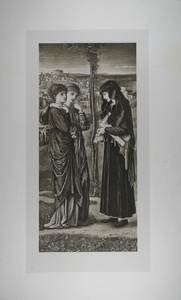| Method | Photogravure |
| Artist | after Sir Edward Coley Burne-Jones |
| Published | Published by the Berlin Photographic Company Berlin. _ London W.133 New Bond Street. _ New York 14 East 23rd Street. [c.1900] |
| Dimensions | Image 391 x 185 mm, Plate 462 x 243 mm, Sheet 667 x 507 mm |
| Notes |
Printed on India laid paper. Plate 12, taken from Burne-Jones' 1870 watercolour of the same title, from 'The Work of Edward Burne-Jones, Ninety-One Photogravures Directly Reproduced from the Original Paintings'. Only two-hundred copies of the 'The Work of Edward Burne-Jones...' were produced, each of which was signed by Philip Burne-Jones, the eldest son of Edward. Burne-Jones' elegant and classically inspired 'Love Disguised as Reason' presents two young maidens encountering Cupid, the god of love. Cupid, however, is disguised, wearing the cloak and hood of Reason. Tucked beneath his arm is a book, along with his bow, alluding to his true identity. The two maidens listen intently, and ponder over Cupid's words. Drawing upon Burne-Jones' fascination with the Italian Old Masters, he sets the figures against an overtly Italianate landscape and distant city view. Similar to many works produced by artists associated with the Aesthetic Movement, 'Love Disguised as Reason' contains no literary narrative, nor offers a moral dialogue. The watercolour on which this photogravure is based is currently in the collection of the South Africa National Gallery, in Cape Town. Held in the collection of the William Morris Gallery, Walthamstow, Birmingham, is a completed compositional drawing, which also dates to 1870. Interestingly, although the figures in the watercolour are completely clothed, in the drawing, they are presented as nude. The drawing appears to lend to the notion that Burne-Jones took the utmost care in studying the figures he featured in his work. Sir Edward Coley Burne-Jones, 1st Bt (1833-1898) was a painter and designer closely associated with the later phase of the Pre-Raphaelite movement. Burne-Jones met William Morris as an undergraduate of Exeter College, Oxford, whilst studying for a degree in theology. The pair went on to work very closely together on numerous decorative arts projects including stained glass windows, tapestries, and illustrations. Originally intending to become a church minister, Burne-Jones never finished his degree, choosing instead to pursue an artistic career under the influence of Dante Gabriel Rossetti. Rossetti heavily inspired his early work, but by the 1860's his idiosyncratic style was beginning to develop. His mature work, however different in total effect, is rich in conscious echoes of Botticelli, Mantegna and other Italian masters of the Quattrocento. Thusly, Burne Jones' later paintings of classical and medieval subjects are some of the most iconic of the Pre-Raphaelite movement. He was at the height of his popularity during the 1880's, though his reputation began to decline with the onset of the Impressionists. He was created a baronet in 1894, when he formally hyphenated his name. The Berlin Photographic Company, (1880 - 1920; fl) or the Berlin Photographische Gesellschaft, was a German print publishers who specialised in photogravures after Old Masters and contemporary painters. High quality photographs were taken of the original works. The negatives were then exposed onto a gelatin covered copper plate, etched with acid, and printed in a similar fashion to an engraving. The main series of the Berlin Photographic Company's publications is kept together at Blythe House, West Kensington. Condition: Some foxing and discolouration to margins, with large stains to upper right and lower left corners of sheet, although not affecting image. |
| Framing | unmounted |
| Price | £400.00 |
| Stock ID | 41493 |

